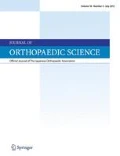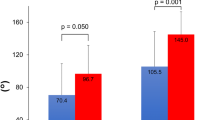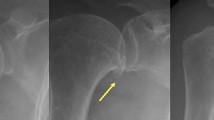Abstract
Background
Rotator cuff tear is considered to be a common source of shoulder pain and dysfunction. Osteoarthritis of the glenohumeral joint (OAG) may coexist with rotator cuff tear, especially in elderly patients. The aim of the study was to evaluate the effect of associated OAG on the treatment outcome of rotator cuff repair.
Methods
A total of 85 consecutive shoulders with an arthroscopically repaired isolated full-thickness supraspinatus tendon tear in males were included in this study. The grade of OAG was estimated preoperatively from shoulder radiographs using the Kellgren–Lawrence (K–L) classification, and peroperatively using the Outerbridge classification. Supraspinatus tendon tear was re-inserted anatomically to the native footprint in all cases. The Constant score was used as an outcome measure and was measured preoperatively and 1 year after the operation. The effect of OAG on the Constant score was analyzed statistically.
Results
82 shoulders (96.5 %) were available for the 1-year follow-up. Preoperative OAG was detected in 22/82 patients (26.8 %). Any OAG above K–L grade 0 was associated with a lower Constant score preoperatively [49.9 (SD 17.6) vs. 60.1 (SD 16.7) (p = 0.0185)] and also at the 1-year follow-up [73.9 (SD 17.5) vs. 82.8 (SD 10.9) (p = 0.0074)]. 16/60 patients (26.7 %) with K–L grade 0 radiographs had peroperatively detected OAG. Furthermore, any peroperatively detected OAG was associated with a lower Constant score preoperatively [53.2 (SD 19.0) vs. 60.9 (SD 15.2) (p = 0.0445)] and at the 1-year follow-up 76.8 [(SD 14.8) vs. 83.5 (SD 11.4) (p = 0.0223)].
Conclusion
OAG is a relatively common finding in operated supraspinatus tear patients. Pre- and peroperatively detected OAG during rotator cuff reconstruction is predictive for lower pre- and postoperative Constant scores.

Similar content being viewed by others
References
Yamaguchi K, Ditsios K, Middleton WD, Hildebolt CF, Galatz LM, Teefey SA. The demographic and morphological features of rotator cuff disease. A comparison of asymptomatic and symptomatic shoulders. J Bone Joint Surg Am. 2006;88:1699–704.
Milgrom C, Schaffler M, Gilbert S, van Holsbeeck M. Rotator-cuff changes in asymptomatic adults. The effect of age, hand dominance and gender. J Bone Joint Surg Br. 1995;77:296–8.
Sher JS, Uribe JW, Posada A, Murphy BJ, Zlatkin MB. Abnormal findings on magnetic resonance images of asymptomatic shoulders. J Bone Joint Surg Am. 1995;77:10–5.
Kernwein GA. Roentgenographic diagnosis of shoulder dysfunction. JAMA. 1965;194:1081–5.
Miller C, Savoie FH. Glenohumeral abnormalities associated with full-thickness tears of the rotator cuff. Orthop Rev. 1994;23:159–62.
Accousti KJ, Flatow EL. Technical pearls on how to maximize healing of the rotator cuff. Instr Course Lect. 2007;56:3–12.
Cofield RH, Parvizi J, Hoffmeyer PJ, Lanzer WL, Ilstrup DM, Rowland CM. Surgical repair of chronic rotator cuff tears. A prospective long-term study. J Bone Joint Surg Am. 2001;83-A:71–7.
Goutallier D, Postel JM, Lavau L, Bernageau J. Impact of fatty degeneration of the suparspinatus and infraspinatus muscles on the prognosis of surgical repair of the rotator cuff. Rev Chir Orthop Reparatrice Appar Mot. 1999;85:668–76.
Iannotti JP, Bernot MP, Kuhlman JR, Kelley MJ, Williams GR. Postoperative assessment of shoulder function: a prospective study of full-thickness rotator cuff tears. J Shoulder Elbow Surg. 1996;5:449–57.
Shen PH, Lien SB, Shen HC, Lee CH, Wu SS, Lin LC. Long-term functional outcomes after repair of rotator cuff tears correlated with atrophy of the supraspinatus muscles on magnetic resonance images. J Shoulder Elbow Surg. 2008;17:1S–7S.
Klinger HM, Steckel H, Ernstberger T, Baums MH. Arthroscopic debridement of massive rotator cuff tears: negative prognostic factors. Arch Orthop Trauma Surg. 2005;125:261–6.
Post M, Silver R, Singh M. Rotator cuff tear. Diagnosis and treatment. Clin Orthop Relat Res. 1983;173:78–91.
Kellgren JH, Lawrence JS. Radiological assessment of osteo-arthrosis. Ann Rheum Dis. 1957;16:494–502.
Outerbridge RE, Dunlop JA. The problem of chondromalacia patellae. Clin Orthop Relat Res. 1975;110:177–96.
Umans HR, Pavlov H, Berkowitz M, Warren RF. Correlation of radiographic and arthroscopic findings with rotator cuff tears and degenerative joint disease. J Shoulder Elbow Surg. 2001;10:428–33.
Gartsman GM, Taverna E. The incidence of glenohumeral joint abnormalities associated with full-thickness, reparable rotator cuff tears. Arthroscopy. 1997;13:450–5.
Gilbart MK, Gerber C. Comparison of the subjective shoulder value and the Constant score. J Shoulder Elbow Surg. 2007;16:717–21.
Charousset C, Grimberg J, Duranthon LD, Bellaiche L, Petrover D, Kalra K. The time for functional recovery after arthroscopic rotator cuff repair: correlation with tendon healing controlled by computed tomography arthrography. Arthroscopy. 2008;24:25–33.
Levy O, Venkateswaran B, Even T, Ravenscroft M, Copeland S. Mid-term clinical and sonographic outcome of arthroscopic repair of the rotator cuff. J Bone Joint Surg Br. 2008;90:1341–7.
Lichtenberg S, Liem D, Magosch P, Habermeyer P. Influence of tendon healing after arthroscopic rotator cuff repair on clinical outcome using single-row Mason–Allen suture technique: a prospective, MRI controlled study. Knee Surg Sports Traumatol Arthrosc. 2006;14:1200–6.
Sugaya H, Maeda K, Matsuki K, Moriishi J. Functional and structural outcome after arthroscopic full-thickness rotator cuff repair: single-row versus dual-row fixation. Arthroscopy. 2005;21:1307–16.
Kerr R, Resnick D, Pineda C, Haghighi P. Osteoarthritis of the glenohumeral joint: a radiologic-pathologic study. AJR Am J Roentgenol. 1985;144:967–72.
Petersson CJ. Degeneration of the gleno-humeral joint. An anatomical study. Acta Orthop Scand. 1983;54:277–83.
Hsu HC, Luo ZP, Stone JJ, Huang TH, An KN. Correlation between rotator cuff tear and glenohumeral degeneration. Acta Orthop Scand. 2003;74:89–94.
Braune C, Gramlich H, Habermeyer P. The macroscopic aspect of rotator cuff tears in traumatic and nontraumatic rupture cases. Unfallchirurg. 2000;103:462–7.
Ruckstuhl H, de Bruin ED, Stussi E, Vanwanseele B. Post-traumatic glenohumeral cartilage lesions: a systematic review. BMC Musculoskelet Disord. 2008;9:107.
Sekiya JK, Jolly J, Debski RE. The effect of a Hill–Sachs defect on glenohumeral translations, in situ capsular forces, and bony contact forces. Am J Sports Med. 2012;40:388–94.
Conflict of interest
The authors declare that they have no conflict of interest.
Author information
Authors and Affiliations
Corresponding author
Additional information
Study design: level III, clinical retrospective comparative registry study.
About this article
Cite this article
Kukkonen, J., Joukainen, A., Lehtinen, J. et al. The effect of glenohumeral osteoarthritis on the outcome of isolated operatively treated supraspinatus tears. J Orthop Sci 18, 405–409 (2013). https://doi.org/10.1007/s00776-013-0369-2
Received:
Accepted:
Published:
Issue Date:
DOI: https://doi.org/10.1007/s00776-013-0369-2




